Mahabalipuram Temples: The Lost Pagodas, Shore Temple & Secrets Beneath the Sea
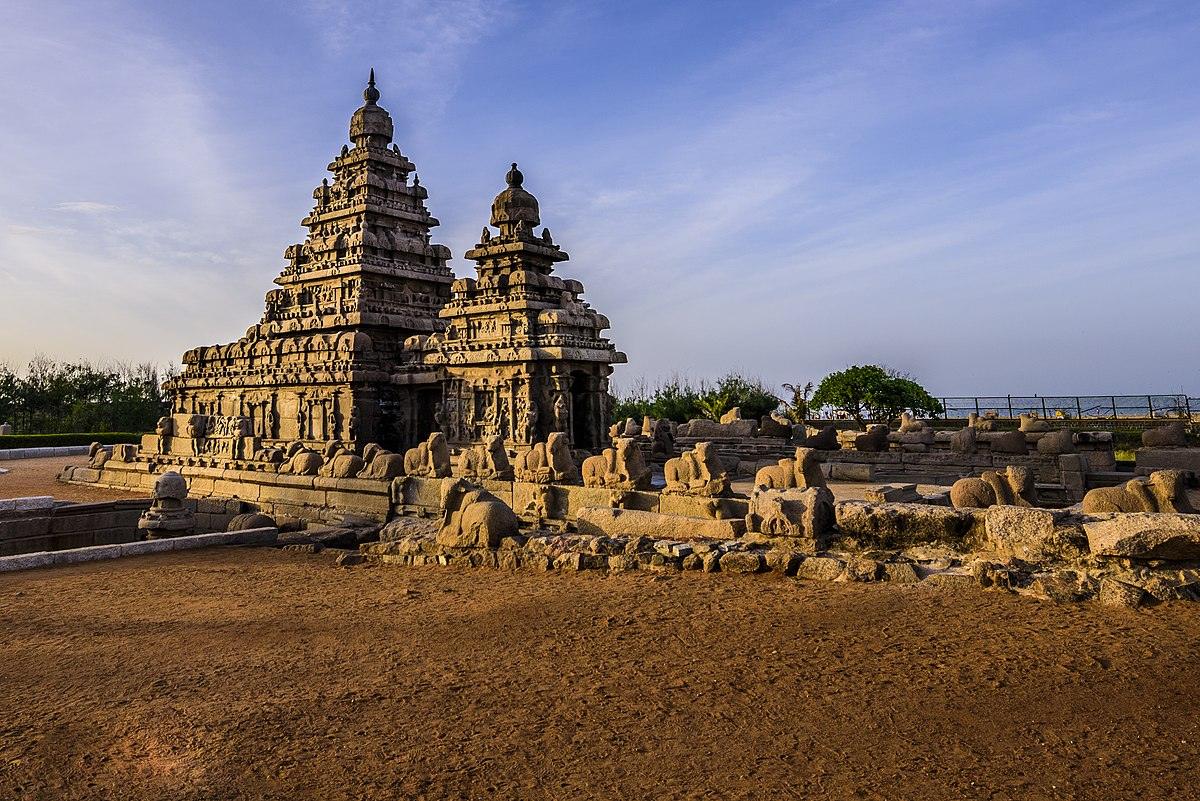
Imagine a town where the sea itself guards legends. Mahabalipuram, or Mamallapuram, is home to the fabled Seven Pagodas Mahabalipuram, of which only the stunning mahabalipuram shore temple still rises proudly by the Bay of Bengal. This seaside shrine is just one of many Mahabalipuram temples by the sea, alongside dramatic rock-cut cave temples Mahabalipuram, ornate rathas like the five rathas mahabalipuram, and intricately carved mandapas. Declared a Mamallapuram UNESCO site, the town is a living museum of Pallava artistry, blending myth, architecture, and devotion. Whether it’s the Varaha Cave Temple Mahabalipuram, the Pancha Pandava Cave Temple, or the still-active Sthalasayana Perumal Temple, every corner whispers centuries-old tales. For travellers searching for Mahabalipuram temple history, here’s your guide to exploring these timeless wonders.
In this Blog
Shore Temple
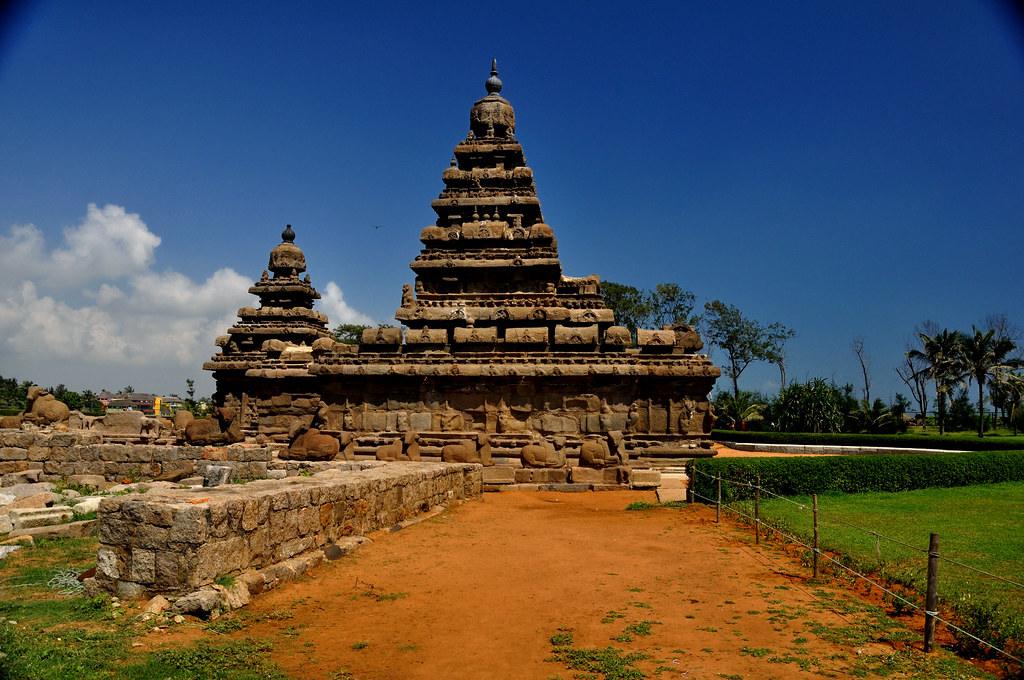
The Shore Temple Mahabalipuram is the crown jewel of this town, a granite sentinel that has faced the Bay of Bengal since the 8th century. Built under King Narasimhavarman II, it was one of the earliest structural temples in South India, a departure from the cave-cut style that defined earlier monuments. Inside the complex are three shrines: two dedicated to Lord Shiva and one to Lord Vishnu reclining on the serpent Ananta. This rare mix of deities reflects the Pallavas’ inclusive religious outlook.
The temple is central to the Seven Pagodas Mahabalipuram legend. While six others are said to have been claimed by the sea, the Shore Temple continues to shine, especially at sunrise when it glows golden against the ocean. It has endured cyclones, tsunamis, and salt erosion, yet still stands proud – a UNESCO World Heritage marvel and one of the top places to visit in Mahabalipuram.
- Location: Beachfront, Mahabalipuram, Tamil Nadu (60 km from Chennai).
- Timings: 6:00 am – 6:00 pm daily.
- Entry fee: ₹40 (Indians), ₹600 (foreigners).
Olakkannesvara Temple
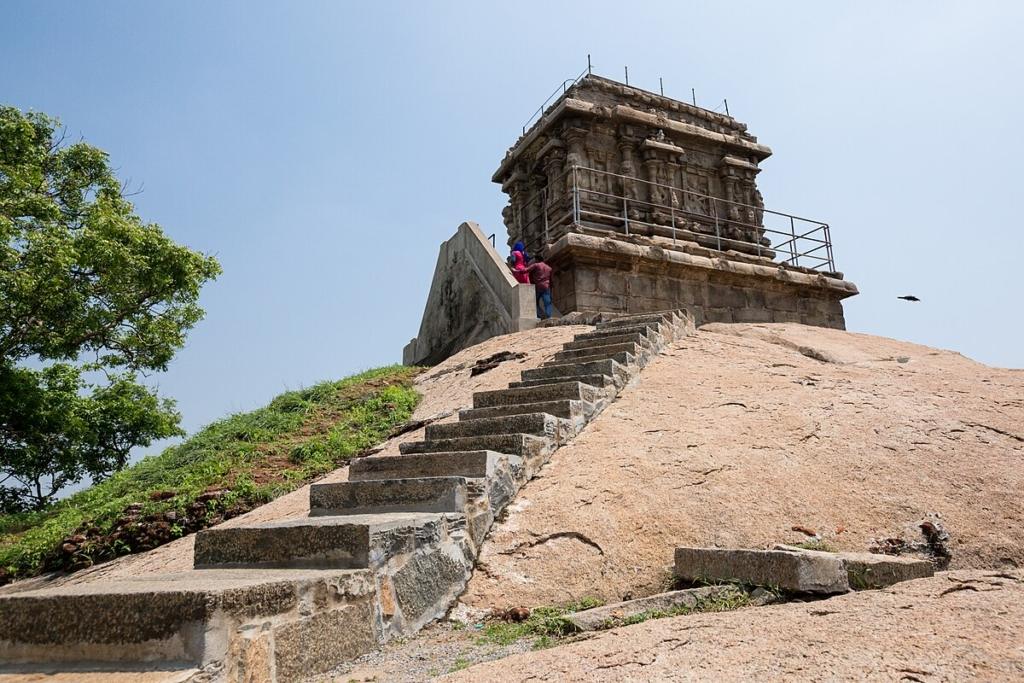
Perched on a rocky outcrop above the coast, the Olakkannesvara Temple offers sweeping views of the Bay of Bengal. Built in the 8th century and dedicated to Shiva, it isn’t directly on the sand like the Shore Temple Mahabalipuram, but it commands a vantage point that once guided sailors. Fires lit at the top are believed to have served as a beacon, making it an “Old Lighthouse” centuries before the modern one nearby.
Though partially ruined today, the temple is atmospheric especially if you visit during the best time to visit Mahabalipuram which is from November to February. Watching the sun rise or set from here is unforgettable: below you, the Shore Temple glows like amber; in front, the ocean stretches endlessly. If you’re interested in knowing about Mahabalipuram’s history and facts, Olakkannesvara shows how Pallava architecture was not just spiritual but also practical, blending religion with maritime utility.
- Location: Hillock above Mahishasuramardini Mandapa, overlooking the shore.
- Timings: 6:00 am – 6:00 pm daily.
- Entry fee: Covered under UNESCO group ticket.
Varaha Cave Temple
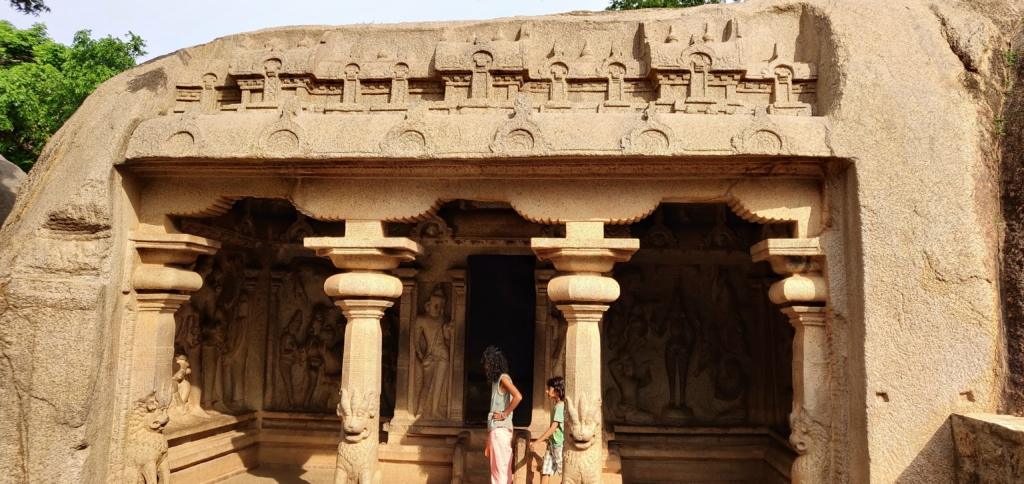
The Varaha Cave Temple Mahabalipuram is a stunning example of Pallava artistry in the rock-cut cave temples Mahabalipuram is famous for. Dedicated to Vishnu, it depicts the Varaha avatar lifting the Earth goddess Bhudevi from the cosmic ocean. The relief is powerful—Varaha poised, tusks raised, Bhudevi calm yet vulnerable. For a town where the sea is ever-present, this myth carved in stone feels deeply symbolic.
The columns, resting on lion bases, are hallmarks of Pallava style. The cave is small compared to the Shore Temple Mahabalipuram, but its details are intricate and alive. Every curve and expression tells a story, making it a must-visit for anyone interested in knowing Mahabalipuram history and facts. Paired with Arjuna’s Penance nearby, this temple is also a convenient stop for travelers tracing the mythological narratives of the Pallavas.
- Location: Near Arjuna’s Penance, central Mahabalipuram.
- Timings: 9:00 am – 5:30 pm daily.
- Entry fee: Included in UNESCO ticket.
Panchapandava Cave Temple
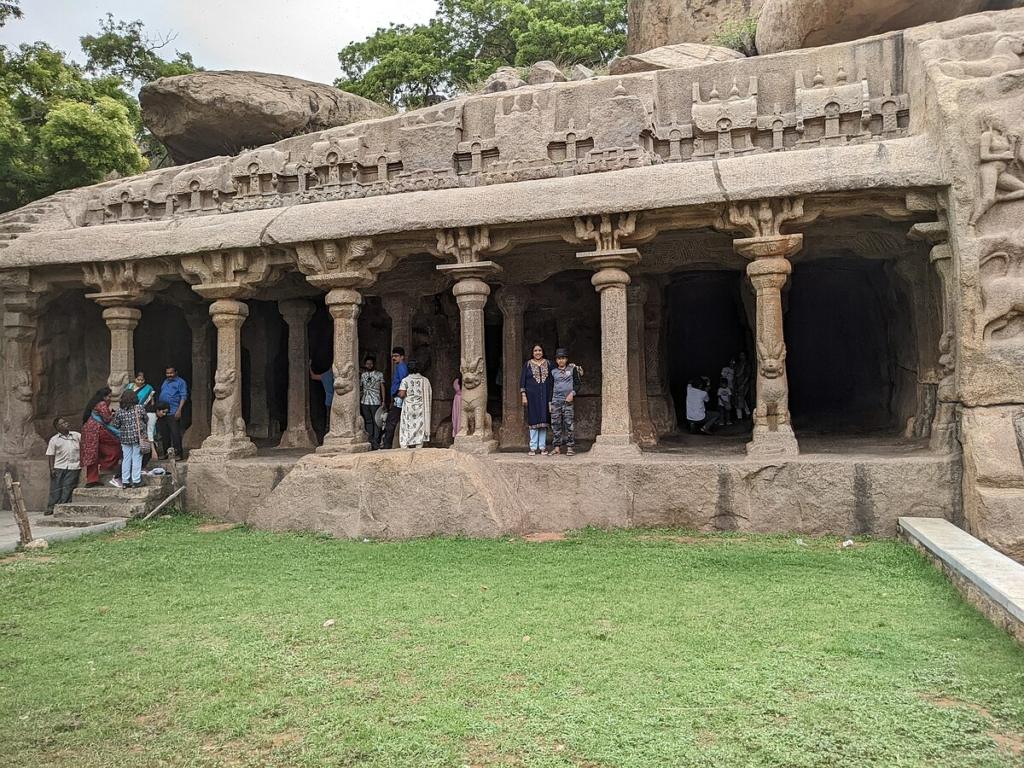
The Pancha Pandava Cave Temple (also called the Panchapandava Cave Temple) is the largest cave mandapa in Mahabalipuram, carved into the hillside with sweeping halls and multiple chambers. Named after the Pandavas from the Mahabharata, it was never completed, yet its scale is awe-inspiring. Even unfinished, the mandapa showcases the Pallavas’ ambition and technical genius.
While not on the beach like the temples by the sea Mahabalipuram is known for, it belongs to the same Mamallapuram UNESCO site and is an essential stop for history enthusiasts. Standing inside its pillared hall, you feel dwarfed by stone, as if the mythological heroes themselves could stride in at any moment. For those researching Mahabalipuram temple history, this cave temple is a reminder that art sometimes lies in grandeur, even when incomplete.
- Location: Hill area near Krishna’s Butterball.
- Timings: 9:00 am – 5:30 pm daily.
- Entry fee: Included in UNESCO ticket.
Mahishasuramardini Mandapa
Carved into a rocky hillside, the Mahishasuramardini Mandapa Mahabalipuram is one of the most dramatic shrines in the region. On one side, Goddess Durga is depicted slaying the buffalo demon Mahishasura, her lion mount roaring into the fray. On the other, Vishnu reclines serenely on the serpent Ananta. Together, the panels create a striking contrast—rage and calm carved into the same stone canvas.
The mandapa is small, but its impact is huge. Located just below the Olakkannesvara Temple, it also offers coastal views, making it one of the best-positioned rock-cut cave temples Mahabalipuram has to offer.
- Location: Hill slope near Olakkannesvara Temple.
- Timings: 9:00 am – 5:30 pm daily.
- Entry fee: Included in UNESCO ticket.
Ganesha Ratha
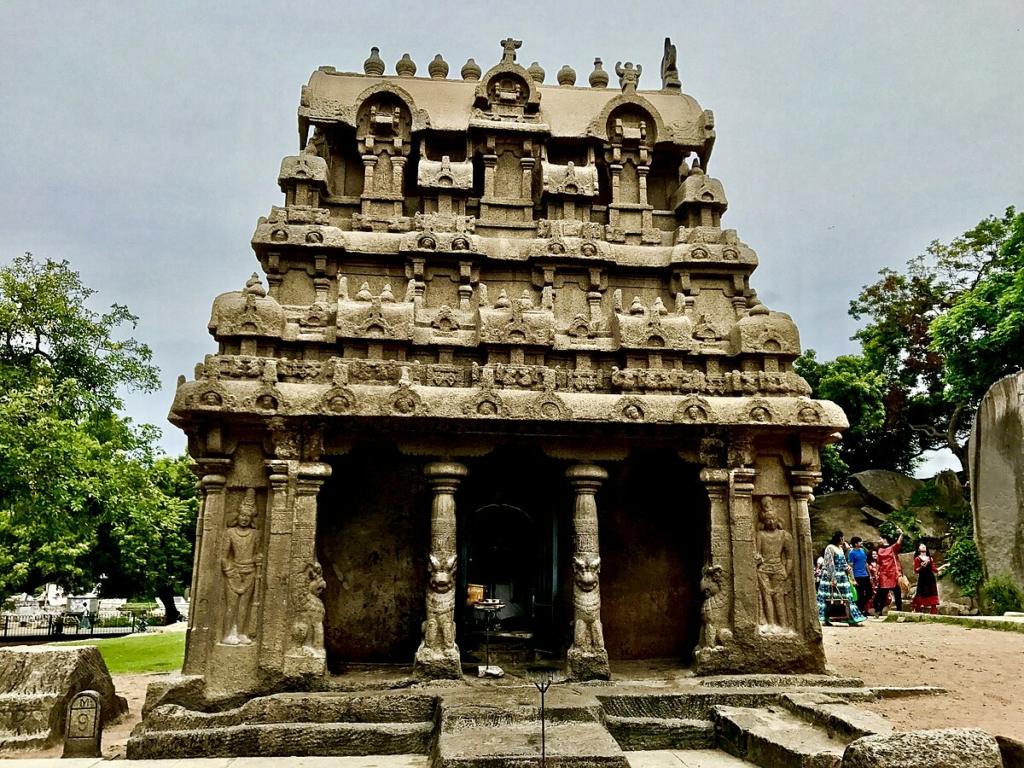
The Ganesha Ratha is a monolithic marvel, carved entirely from a single block of granite. Originally dedicated to Shiva, it now houses a Ganesha idol and remains a living place of worship—unlike many other monuments that serve only as heritage sites. This continuity of devotion makes it special among Mahabalipuram temples.
Its chariot-like design reflects the Pallavas’ experimentation with temple forms and links it stylistically to the celebrated five rathas mahabalipuram, where each structure is carved from a single stone. Though not directly on the coast like the mahabalipuram shore temple, it embodies the artistry that makes this town unique. For visitors exploring Mahabalipuram temple history, Ganesha Ratha offers both heritage and spirituality in one stop.
- Location: Near Krishna’s Butterball, central Mahabalipuram.
- Timings: 9:00 am – 5:30 pm daily.
- Entry fee: Included in UNESCO ticket.
Arjuna’s Penance
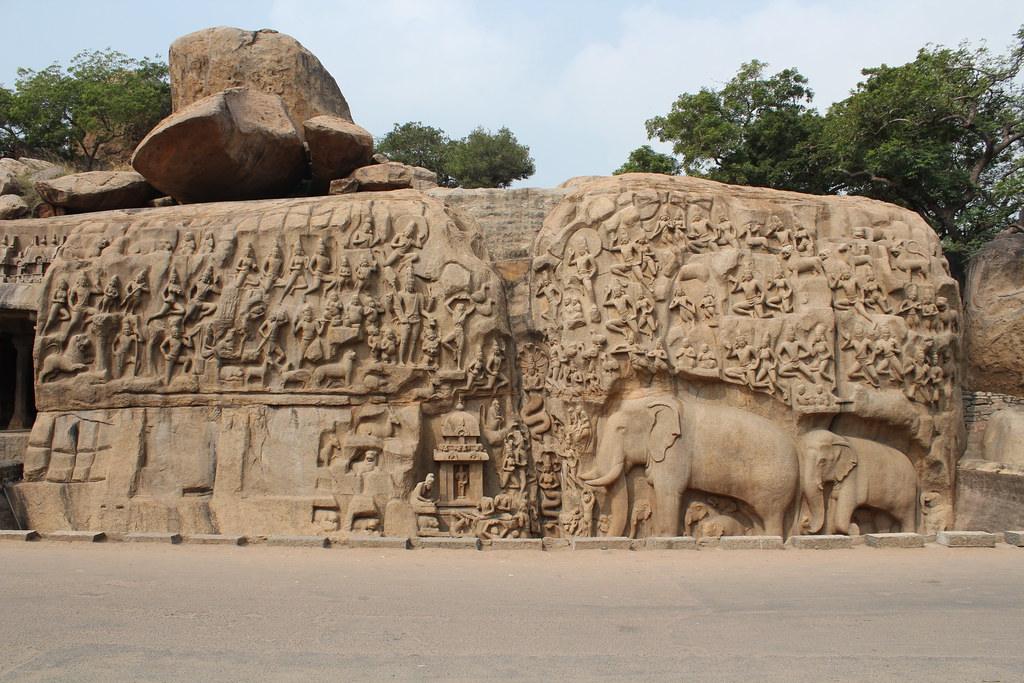
Also known as the Descent of the Ganges, Arjuna’s Penance is the world’s largest open-air bas-relief. Carved on two massive boulders, it portrays mythological scenes teeming with elephants, sages, celestial beings, and cats performing penance. Some say it depicts Arjuna meditating to gain a divine weapon; others believe it shows the descent of the holy Ganga.
Not a temple but a monumental narrative, it is central to Mahabalipuram myths and legends. Standing before this relief, you feel the stone almost speaking, each figure etched with astonishing precision. For travellers, it’s one of the top things to know about Shore Temple’s wider context—that Mahabalipuram is as much about storytelling as it is about shrines.
- Location: Near Varaha Cave Temple, central Mahabalipuram.
- Timings: 6:00 am – 6:00 pm daily.
- Entry fee: Included in UNESCO ticket.
Sthalasayana Perumal Temple
Amid all the monuments, the Sthalasayana Perumal Temple is unique because it’s still active. Dedicated to Vishnu in a reclining pose, it is one of the 108 Divya Desams revered by Vaishnavites. Unlike the structural or cave monuments, this temple is about ongoing devotion, rituals, and festivals.
Though inland, it adds balance to the narrative of Mahabalipuram temples, showing that the town is not just an archaeological site but also a living place of worship. For those looking beyond the rock-cut cave temples Mahabalipuram is famous for, this shrine connects past grandeur with present spirituality.
- Location: Near the main town, walking distance from Shore Temple.
- Timings: 6:00 am – 12:00 pm, 3:00 pm – 8:00 pm daily.
- Entry fee: Free.
Tiger Cave
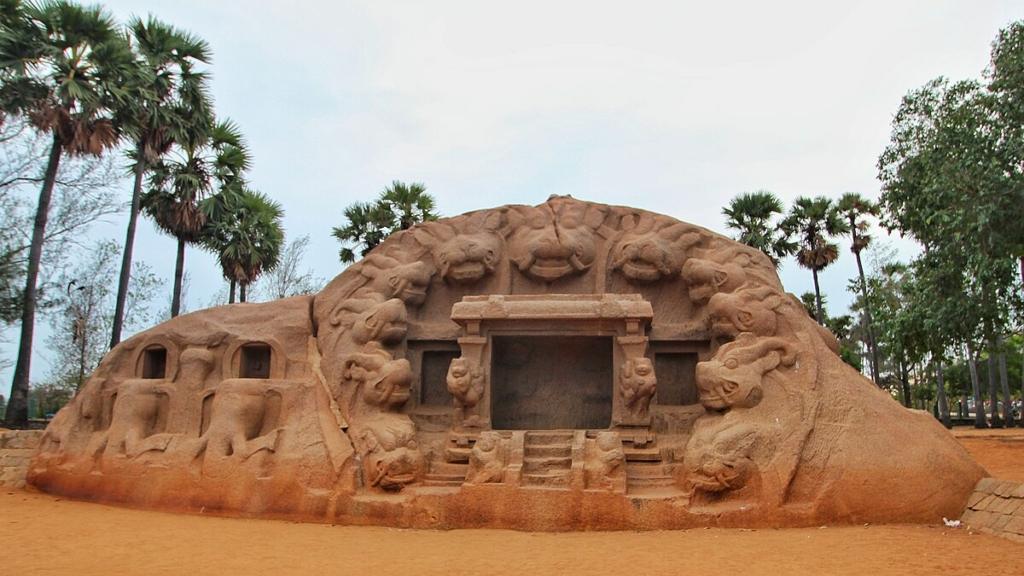
Ksaravanakumar via Wikimedia
Just outside Mahabalipuram lies the Tiger Cave Mahabalipuram, decorated with yali (mythical tiger-like creatures). Built during the Pallava period, it was likely used for cultural performances and gatherings. Today, it’s a picnic spot popular with locals, offering a more relaxed vibe than the central monuments.
Though small compared to the Shore Temple Mahabalipuram or Varaha Cave Temple Mahabalipuram, it adds another layer to Mahabalipuram history and facts. It reminds visitors that the Pallavas created not just temples but also public spaces that merged art, leisure, and community.
- Location: 5 km north of Mahabalipuram.
- Timings: 6:00 am – 6:00 pm daily.
- Entry fee: Free.
Karukathamman Temple
While most guides focus on the UNESCO monuments, the Karukathamman Temple also deserves mention. This smaller yet locally revered shrine is a reminder that Mahabalipuram isn’t just about Pallava-era carvings but also about living traditions that have continued through centuries. Many travelers include it in their pilgrimage circuit after visiting the larger Mahabalipuram temples like the Shore Temple or five rathas Mahabalipuram.
- Location: In Mahabalipuram town.
- Timings: 6:00 am – 12:00 pm, 4:00 pm – 8:00 pm.
- Entry fee: Free.
Tips for Travelling to Mahabalipuram
- Best time to visit Mahabalipuram: November to February, when the weather is cooler.
- Mahabalipuram temples timings entry fee: The Shore Temple opens at sunrise and closes at sunset; tickets are modest for Indians and higher for foreign visitors.
- Plan for half a day at least if you want to do justice to both the Shore Temple Mahabalipuram and the inland caves like the Varaha Cave Temple Mahabalipuram.
From the Mahabalipuram shore temple glowing at sunrise to the carvings of the Varaha Cave Temple Mahabalipuram and the grandeur of the Pancha Pandava Cave Temple, these sites aren’t just monuments. They’re living legends—some standing tall by the sea, some tucked inland, and some perhaps lost beneath the waves.
For travelers chasing Mahabalipuram temple history, this is a destination where gods, kings, and myths collide. Whether you’re planning a weekend getaway from Chennai, searching for things to know about Shore Temple, exploring the iconic five rathas mahabalipuram, or visiting lesser-known shrines like the Karukathamman Temple, this coastal town promises a journey that is part spiritual, part historical, and wholly unforgettable.
Cover Image Credits: Rvk1982 via Wikimedia





